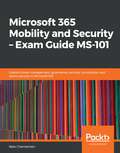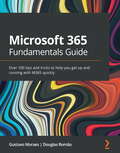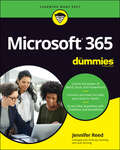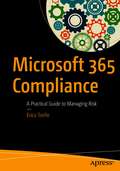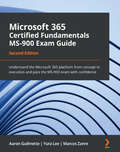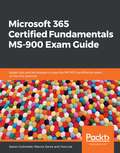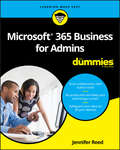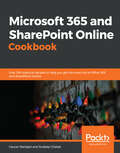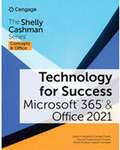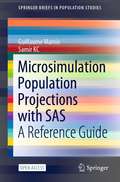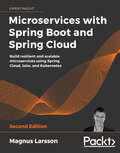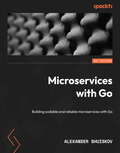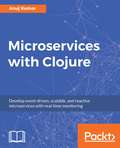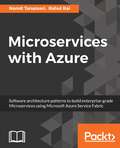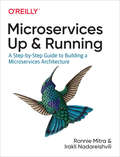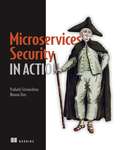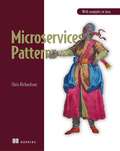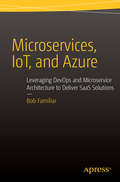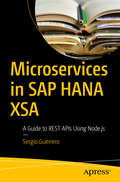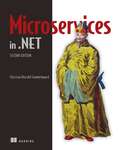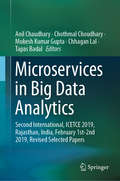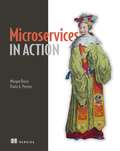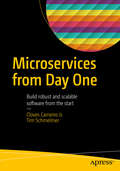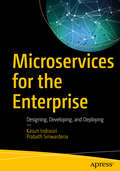- Table View
- List View
Microsoft 365 Mobility and Security - Exam Guide MS 101: Explore Threat Management, Governance, Security, Compliance, And Device Services In Microsoft 365
by Nate ChamberlainThis book is ideal for professionals seeking the M365 Enterprise Administrator Expert certification. Audience will have already taken or plan to take MS-100 as well, and have experience or interest in administering the entirety of a Microsoft 365 tenant and its services.
Microsoft 365 Fundamentals Guide: Over 100 tips and tricks to help you get up and running with M365 quickly
by Gustavo Moraes Douglas RomaoBecome a Microsoft 365 superuser and overcome challenges using the wide range of features offered by Microsoft 365 apps including SharePoint, Teams, Power Automate, Planner, and To-DoKey FeaturesEnhance your productivity with this consolidated guide to using all the tools available in Microsoft 365Improve your collaboration and maximize efficiency using various M365 featuresIntegrate project, task, and people management within one ecosystemBook DescriptionWith its extensive set of tools and features for improving productivity and collaboration, Microsoft 365 is being widely adopted by organizations worldwide. This book will help not only developers but also business people and those working with information to discover tips and tricks for making the most of the apps in the Microsoft 365 suite.The Microsoft 365 Fundamentals Guide is a compendium of best practices and tips to leverage M365 apps for effective collaboration and productivity. You'll find all that you need to work efficiently with the apps in the Microsoft 365 family in this complete, quick-start guide that takes you through the Microsoft 365 apps that you can use for your everyday activities. You'll learn how to boost your personal productivity with Microsoft Delve, MyAnalytics, Outlook, and OneNote. To enhance your communication and collaboration with teams, this book shows you how to make the best use of Microsoft OneDrive, Whiteboard, SharePoint, and Microsoft Teams. You'll also be able to be on top of your tasks and your team's activities, automating routines, forms, and apps with Microsoft Planner, To-Do, Power Automate, Power Apps, and Microsoft Forms.By the end of this book, you'll have understood the purpose of each Microsoft 365 app, when and how to use it, and learned tips and tricks to achieve more with M365.What you will learnUnderstand your Microsoft 365 apps betterApply best practices to boost your personal productivityFind out how to improve communications and collaboration within your teamsDiscover how to manage tasks and automate processesGet to know the features of M365 and how to implement them in your daily activitiesBuild an integrated system for clear and effective communicationWho this book is forWhether you're new to Microsoft 365 or an existing user looking to explore its wide range of features, you'll find this book helpful. Get started using this introductory guide or use it as a handy reference to explore the features of Microsoft 365. All you need is a basic understanding of computers.
Microsoft 365 For Dummies
by Jennifer ReedAmp up your collaboration skills and rock the modern workplace by harnessing the power of Microsoft 365 with this one-stop guide to the world's leading productivity platform The Microsoft 365 productivity solution for the workplace is a cloud-based service with many features for effective and secure collaboration virtually or in person. Whether you start your day with meetings in Teams, respond to Outlook emails, create documents with Office apps, or even automate your work with artificial intelligence, Microsoft 365 has you covered. But first, you must unlock the potential of this powerful solution to showcase your ability to keep up with the modern workplace and make an impact in your organization. To do that, you need Microsoft 365 For Dummies! This book walks you through the steps to get your work done anytime, anywhere, on any device, with Microsoft Teams as the central hub. Discover how to chat online in real time; conduct online meetings; co-author documents in the cloud; develop no-code applications; and even prioritize your well-being. The insights and step-by-step guidance in Microsoft 365 For Dummies will help you stay connected and engaged with your colleagues. Level up your teamwork game with the latest meeting and collaboration best practices from Microsoft Teams Stretch your use of Office apps (Word, Excel, PowerPoint, Outlook, and OneNote) by infusing artificial intelligence into your everyday tasks Save time (and look really smart) by automating your work with the Power Platform apps Take a break from work and focus on your health and well-being at home or in the office Whether you’re a Microsoft 365 newbie or a superuser looking for details on what's new, Microsoft 365 For Dummies is the friendly and authoritative how-to book you need. Discover the benefits of cloud technology today!
Microsoft 365 Compliance: A Practical Guide to Managing Risk
by Erica ToelleUse the information presented in this book to implement an end-to-end compliance program in your organization using Microsoft 365 tools. You will learn about the solutions available in the Microsoft 365 Compliance Center, including best practices and common pitfalls. IT professionals will benefit from the author’s approach of introducing each topic within a practical business context and scenarios behind the “whys” of compliance. Compliance managers will understand how to implement their requirements in Microsoft 365. Compliance and risk management is often a board- or CEO-level issue. The risks of hefty fines and bad PR from non-compliance are severe. IT is usually responsible for implementing compliance controls and for working with compliance and legal officers to manage the day-to-day risk in an organization. After reading Microsoft 365 Compliance, you will be prepared to have a well-informed conversation with your compliance and legal officers to determine how to work together to identify specific compliance requirements for your organization. You will be able to implement those requirements yourself using Microsoft 365 features. Compliance and legal officers will understand how to communicate their technical requirements to IT. Author Erica Toelle helps you build a solid compliance foundation by teaching you about topics such as information protection, retention, records management, eDiscovery, auditing, compliance with common regulations, managing insider risks, supervising communications, data loss prevention, protecting sensitive information, and using machine learning to reduce compliance costs. What You Will Learn Understand typical business scenarios and requirements for a Microsoft 365 compliance program Fulfill these compliance scenarios and requirements using out of the box Microsoft 365 solutions and functionality Ensure that your Microsoft 365 implementation meets standard compliance regulations, such as GDPR and ISO/IEC 27001:2013 Enlist best practices and things to know when implementing Microsoft 365 solutions Comprehend required Microsoft licensing and how to implement a least permissions model for each compliance solution Explore what you can accomplish using the compliance center user interface, without custom scripting or code This book is for IT professionals, security managers, compliance officers, risk managers, internal audit, records managers, CIOs, and anyone who would like to learn more about Microsoft 365 compliance. ·
Microsoft 365 Certified Fundamentals MS-900 Exam Guide: Understand the Microsoft 365 platform from concept to execution and pass the MS-900 exam with confidence, 2nd Edition
by Aaron Guilmette Yura Lee Marcos ZanreExplore the latest MS-900 exam skills and concepts with this updated second editionKey FeaturesWork with self-assessment questions, exam tips, and mock tests based on the latest exam patternThis updated second edition covers concepts including Microsoft Forms, Microsoft 365 Security Center, and moreUnderstand the security considerations and benefits of adopting different types of cloud servicesBook DescriptionMicrosoft 365 Certified Fundamentals certification demonstrates your foundational knowledge of adopting cloud services, specifically the software as a service (SaaS) model. Exam MS-900 tests your understanding of Microsoft 365 services, components, their implementation, security, licensing, and general cloud concepts. This updated second edition covers all the recent and important changes in the examination in detail to help you achieve certification. You'll begin by exploring key topics such as Microsoft security and compliance policies, pricing and support, and cloud concepts. The book helps you to understand these concepts with the help of real-world scenarios, learning about platform services such as Microsoft Windows, SharePoint, Microsoft 365 apps, Teams, and Exchange. The content has been updated to include Microsoft Forms, Power Platform, Microsoft 365 Security Center, Windows Virtual Desktop, and Insider Risk Management. Each chapter contains a section that will test your knowledge of the core concepts covered. Finally, you'll take a practice exam with extra questions to help prepare you for the actual test. By the end of this MS-900 book, you'll be well-equipped to confidently pass the MS-900 certification exam with the help of the updated exam pattern.What you will learnUnderstand cloud services and deployment models, including public and private cloudsFind out the differences between SaaS and IaaS consumption models, and where Microsoft services fit inExplore the reporting and analytics capabilities of Microsoft 365Use Compliance Manager and Security Center to audit your organizationDiscover and implement best practices for licensing options available in Microsoft 365Gain insights into the exam objectives and knowledge required before taking the MS-900 examWho this book is forThis book is for intermediate as well as experienced administrators and individuals looking for tips and tricks to pass the latest MS-900 exam and achieve Microsoft 365 certification. Basic knowledge of Microsoft services and cloud concepts is assumed in order to get the most out of this book.
Microsoft 365 Certified Fundamentals: Expert tips and techniques to pass the MS-900 certification exam on the first attempt
by Aaron Guilmette Marcos ZanreThis book is intended for beginners and experienced administrators and individuals who want to pass the MS-900 as part of the journey to attain other Microsoft 365 certifications. The book assumes a basic knowledge of Microsoft services and cloud concepts.
Microsoft 365 Business for Admins For Dummies
by Jennifer ReedLearn streamlined management and maintenance capabilities for Microsoft 365 Business If you want to make it easy for your teams to work together using the latest productivity solutions with built-in security—while saving thousands of dollars in implementing the solution—you've picked the right book. Inside, you'll gain an understanding of Microsoft 365 Business, a complete integrated solution for business productivity and security powered by Office 365 and Windows 10. You’ll also learn how this cloud-based solution can help grow your business while protecting company data from potential threats using the same security management tools large enterprises use. Microsoft 365 Business For Admins For Dummies provides business owners, IT teams, and even end users an understanding of the capabilities of Microsoft 365 Business: an integrated platform and security solution built with the latest features to enable today's modern workforce and empower businesses to achieve their goals. De-mystifies the complexities of the bundled solution to help you avoid common deployment pitfalls Includes the latest information about the services included in Microsoft 365 Business Enhance team collaboration with intelligent tools Manage company-owned or bring your own device (BYOD) devices from one portal Step through a guided tour for running a successful deployment Get the guidance you need to deploy Microsoft 365 Business and start driving productivity in your organization while taking advantage of the built-in security features in the solution to grow and protect your business today.
Microsoft 365 and SharePoint Online Cookbook: Over 100 actionable recipes to help you perform everyday tasks effectively in Microsoft 365
by Gaurav Mahajan Sudeep GhatakEmbrace modern solutions to enhance collaboration, teamwork, robotic process automation, and business intelligence in your organization using powerful Microsoft 365 services (formerly Office 365) Key Features Gain a complete overview of popular Microsoft 365 services using practical recipes and expert insights Collaborate with your team and external users effectively using SharePoint and Teams Create no-code and low-code solutions, such as bots, forms, dashboards, and workflows, using the Power platform Book Description Microsoft 365 in an integrated suite that provides intelligent tools for managing everyday organizational tasks like content management, communication, creating reports, and automating business processes. With this book, you'll get to grips with popular apps from Microsoft, with a focus on enabling workspace collaboration and productivity using Microsoft SharePoint Online, Teams, and the Power Platform to name a few. In addition to guiding you through the implementation of Microsoft 365 apps, this practical guide helps you to learn from a Microsoft consultant's extensive experience of working with the Microsoft business suite. Starting with a quick overview of the M365 ecosystem, the book covers recipes for implementing SharePoint Online for various content management tasks. You'll learn how to create sites for your organization and enhance collaboration across the business and then see how you can boost productivity with apps such as Microsoft Teams, Power Platform, Planner, Delve, and M365 Groups. Using a step-by-step approach, you'll also find out how to use the Power Platform efficiently, making the most of Microsoft PowerApps, Power Automate, PowerBI, and Power Virtual Agents. Finally, the book focuses on the SharePoint framework, which helps you to build custom Teams and SharePoint solutions. By the end of the book, you'll be equipped with the skills required to set up Microsoft 365 and SharePoint Online and be ready to enhance business productivity using a variety of tools. What you will learn Get to grips with a wide range of apps and cloud services in Microsoft 365 Discover ways to use SharePoint Online to create and manage content Store and share documents using SharePoint Online Improve your search experience with Microsoft Search Leverage the Power Platform to build business solutions with Power Automate, Power Apps, Power BI, and Power Virtual Agents Enhance native capabilities in SharePoint and Teams using the SPFx framework Use Microsoft Teams to meet, chat, and collaborate with colleagues or external users Who this book is for This book is for business professionals, IT administrators, enterprise developers and architects, and anyone who wants to get to grips with using M365 for effective implementation of Microsoft apps. Prior experience with Office 365 and SharePoint will assist with understanding the recipes effortlessly.
Microsoft 365 and Office 2021 (Technology for Success and The Shelly Cashman Series)
by Sandra CableHelping you quickly get up to speed, TECHNOLOGY FOR SUCCESS AND THE SHELLY CASHMAN SERIES MICROSOFT 365 & OFFICE 2021, 1st edition, includes the latest on Microsoft 365 and Office 2021 features along with enhanced support for Mac users. Its trademark step-by-step, screen-by-screen, project-based approach enables you to expand your understanding of Office applications through hands-on experimentation and critical thinking. <p><p>Module Learning Objectives are mapped to Microsoft Office Specialist (MOS) certification objectives, reinforcing the critical skills needed for college and career success. Other Ways boxes reveal alternate click paths to achieve a step, while BTW call-outs offer helpful hints as you work through your projects so you can make the most of Microsoft Office tools. In addition, MindTap and SAM (Skills Assessment Manager) online resources help maximize your study time—and results.
Microsoft: Word 2013 Plain & Simple
by Jay Freedman<p>With this full-color, no-nonsense guide, you'll learn the quickest ways to solve a problem or learn a skill with Microsoft Word 2013. Easy-to-follow steps and concise, straightforward language make learning plain and simple!</p>
Microsimulation Population Projections with SAS: A Reference Guide (SpringerBriefs in Population Studies)
by Guillaume Marois Samir KCThis open access book provides a step-by-step overview on how to build a microsimulation model with SAS. It shows how to convert an already existing multistate projection by age, sex, education and region into a microsimulation model. Two new dimensions are then added, either the labor force participation and the sector of activity, and/or some examples of outputs and alternative scenarios that would not be possible with standard demographic methods. The book also describes how to adapt the model for other countries or other purposes. It also provides details on how to extend and adapt the model for other purposes as well as other use of microsimulation with SAS. The book suggests codes that are easy to understand, so they can be replicated or adapted for other purposes. As such, this book provides a great resource for people with beginner to intermediate knowledge in SAS.
Microservices with Spring Boot and Spring Cloud: Build resilient and scalable microservices using Spring Cloud, Istio, and Kubernetes, 2nd Edition
by Magnus LarssonA step-by-step guide to creating and deploying production-quality microservices-based applicationsKey FeaturesBuild cloud-native production-ready microservices with this comprehensively updated guideUnderstand the challenges of building large-scale microservice architecturesLearn how to get the best out of Spring Cloud, Kubernetes, and Istio in combinationBook DescriptionWith this book, you'll learn how to efficiently build and deploy microservices. This new edition has been updated for the most recent versions of Spring, Java, Kubernetes, and Istio, demonstrating faster and simpler handling of Spring Boot, local Kubernetes clusters, and Istio installation. The expanded scope includes native compilation of Spring-based microservices, support for Mac and Windows with WSL2, and an introduction to Helm 3 for packaging and deployment. A revamped security chapter now follows the OAuth 2.1 specification and makes use of the newly launched Spring Authorization Server from the Spring team. Starting with a set of simple cooperating microservices, you'll add persistence and resilience, make your microservices reactive, and document their APIs using OpenAPI. You'll understand how fundamental design patterns are applied to add important functionality, such as service discovery with Netflix Eureka and edge servers with Spring Cloud Gateway. You'll learn how to deploy your microservices using Kubernetes and adopt Istio. You'll explore centralized log management using the Elasticsearch, Fluentd, and Kibana (EFK) stack and monitor microservices using Prometheus and Grafana. By the end of this book, you'll be confident in building microservices that are scalable and robust using Spring Boot and Spring Cloud.What you will learnBuild reactive microservices using Spring BootDevelop resilient and scalable microservices using Spring CloudUse OAuth 2.1/OIDC and Spring Security to protect public APIsImplement Docker to bridge the gap between development, testing, and productionDeploy and manage microservices with KubernetesApply Istio for improved security, observability, and traffic managementWrite and run automated microservice tests with JUnit, testcontainers, Gradle, and bashWho this book is forThis book is intended for Java and Spring developers and architects who want to learn how to build microservice landscapes from the ground up and deploy them either on-premises or in the cloud, using Kubernetes as a container orchestrator and Istio as a service mesh.No familiarity with microservices architecture is required to get started with this book.
Microservices with Go: Building scalable and reliable microservices with Go
by Alexander ShuiskovBuild, scale, and maintain microservices in Golang with ease.Key FeaturesCreate and organize well-structured Go microservicesLearn industry best practices and gain insights into Go microservice development tools, patterns, and solutionsCover hands-on Golang examples in each chapterBook DescriptionThis book covers the key benefits and common issues of microservices, helping you understand the problems microservice architecture helps to solve, the issues it usually introduces, and the ways to tackle them. You'll start by learning about the importance of using the right principles and standards in order to achieve the key benefits of microservice architecture. The following chapters will explain why the Go programming language is one of the most popular languages for microservice development and lay down the foundations for the next chapters of the book. You'll explore the foundational aspects of Go microservice development including service scaffolding, service discovery, data serialization, synchronous and asynchronous communication, deployment, and testing. After covering the development aspects, you'll progress to maintenance and reliability topics. The last part focuses on more advanced topics of Go microservice development including system reliability, observability, maintainability, and scalability. In this part, you'll dive into the best practices and examples which illustrate how to apply the key ideas to existing applications, using the services scaffolded in the previous part as examples. By the end of this book, you'll have gained hands-on experience with everything you need to develop scalable, reliable and performant microservices using Go.What you will learnGet familiar with the industry's best practices and solutions in microservice developmentUnderstand service discovery in the microservices environmentExplore reliability and observability principlesDiscover best practices for asynchronous communicationFocus on how to write high-quality unit and integration tests in Go applicationsUnderstand how to profile Go microservicesWho this book is forThis book is for all types of developers, from people interested in learning how to write microservices in Go to seasoned professionals who want to take the next step in mastering the art of writing scalable and reliable microservice-based systems. A basic understanding of Go will come in handy.
Microservices with Clojure: Develop event-driven, scalable, and reactive microservices with real-time monitoring
by Anuj Kumar Michael VitzThe common patterns and practices of the microservice architecture and their application using the Clojure programming language. Key Features Relevance of the microservice architecture and benefits of Clojure's functional and simple features to implement it. Learn best practices and common principles to avoid common pitfalls while developing microservices. Learn how to use Pedestal to build your next microservices, secure them using JWT, and monitor them using the ELK stack Book Description The microservice architecture is sweeping the world as the de facto pattern with which to design and build scalable, easy-tomaintain web applications. This book will teach you common patterns and practices, and will show you how to apply these using the Clojure programming language. This book will teach you the fundamental concepts of architectural design and RESTful communication, and show you patterns that provide manageable code that is supportable in development and at scale in production. We will provide you with examples of how to put these concepts and patterns into practice with Clojure. This book will explain and illustrate, with practical examples, how teams of all sizes can start solving problems with microservices. You will learn the importance of writing code that is asynchronous and non-blocking and how Pedestal helps us do this. Later, the book explains how to build Reactive microservices in Clojure that adhere to the principles underlying the Reactive Manifesto. We finish off by showing you various ways to monitor, test, and secure your microservices. By the end, you will be fully capable of setting up, modifying, and deploying a microservice with Clojure and Pedestal. What you will learn Explore the pros and cons of monolithic and microservice architectures Use Clojure to effectively build a reallife application using Microservices Gain practical knowledge of the Clojure Pedestal framework and how to use it to build Microservices Explore various persistence patterns and learn how to use Apache Kafka to build event-driven microservice architectures Secure your Microservices using JWT Monitor Microservices at scale using the ELK stack Deploy Microservices at scale using container orchestration platforms such as KubernetesWho this book is for You should have a working knowledge of programming in Clojure. However, no knowledge of RESTful architecture, microservices, or web services is expected. If you are looking to apply techniques to your own projects, taking your first steps into microservice architecture, this book is for you.
Microservices with Azure
by Namit Tanasseri Rahul RaiArchitect enterprise-grade, Microservice-based solutions using Microsoft Azure Service Fabric. About This Book • Explore architectural patterns for building modern day Microservice-based systems • Learn about Microsoft Service Fabric as a platform to host distributed Microservices • Discover multiple options for hosting Microservices on heterogeneous, cross-platform environments • Learn to configure Azure Service Fabric clusters for enterprise-grade service deployments Who This Book Is For The book is aimed at IT architects, system administrators, and DevOps engineers who have a basic knowledge of the Microsoft Azure platform and are working on, or are curious about, the concepts of Microservices and Microservice architecture. What You Will Learn • Understand the basics of Microservices and how Microsoft Azure fits into the equation • Master Azure Service Fabric architecture and services • Explore Azure Service Fabric application programming models • Comprehensive study of various architecture patterns for building enterprise-grade Microservices • Manage and deploy Microservices on Azure Service Fabric • An insight into the future of Microservices with containers and serverless computing In Detail Microsoft Azure is rapidly evolving and is widely used as a platform on which you can build Microservices that can be deployed on-premise and on-cloud heterogeneous environments through Microsoft Azure Service Fabric. This book will help you understand the concepts of Microservice application architecture and build highly maintainable and scalable enterprise-grade applications using the various services in Microsoft Azure Service Fabric. We will begin by understanding the intricacies of the Microservices architecture and its advantages over the monolithic architecture and Service Oriented Architecture (SOA) principles. We will present various scenarios where Microservices should be used and walk you through the architectures of Microservice-based applications. Next, you will take an in-depth look at Microsoft Azure Service Fabric, which is the best–in-class platform for building Microservices. You will explore how to develop and deploy sample applications on Microsoft Azure Service Fabric to gain a thorough understanding of it. Building Microservice-based application is complicated. Therefore, we will take you through several design patterns that solve the various challenges associated with realizing the Microservices architecture in enterprise applications. Each pattern will be clearly illustrated with examples that you can keep referring to when designing applications. Finally, you will be introduced to advanced topics such as Serverless computing and DevOps using Service Fabric, to help you undertake your next venture with confidence. Style and approach This book introduces its readers to the concept of Microservices and Microsoft Azure Service Fabric as a distributed platform to host enterprise-grade Microservices. It then addresses common architectural challenges associated with the Microservice architecture, using proven architectural patterns.
Microservices: Up and Running
by Ronnie Mitra Irakli NadareishviliMicroservices architectures offer faster change speeds, better scalability, and cleaner, evolvable system designs. But implementing your first microservices architecture is difficult. How do you make myriad choices, educate your team on all the technical details, and navigate the organization to a successful execution to maximize your chance of success? With this book, authors Ronnie Mitra and Irakli Nadareishvili provide step-by-step guidance for building an effective microservices architecture.Architects and engineers will follow an implementation journey based on techniques and architectures that have proven to work for microservices systems. You'll build an operating model, a microservices design, an infrastructure foundation, and two working microservices, then put those pieces together as a single implementation. For anyone tasked with building microservices or a microservices architecture, this guide is invaluable.Learn an effective and explicit end-to-end microservices system designDefine teams, their responsibilities, and guidelines for working togetherUnderstand how to slice a big application into a collection of microservicesExamine how to isolate and embed data into corresponding microservicesBuild a simple yet powerful CI/CD pipeline for infrastructure changesWrite code for sample microservicesDeploy a working microservices application on Amazon Web Services
Microservices Security in Action: Design Secure Network And Api Endpoint Security For Microservices Applications, With Examples Using Java, Kubernetes, And Istio (In Action Ser.)
by Wajjakkara Kankanamge Dias Prabath Siriwardena&”A complete guide to the challenges and solutions in securing microservices architectures.&” —Massimo Siani, FinDynamic Key Features Secure microservices infrastructure and code Monitoring, access control, and microservice-to-microservice communications Deploy securely using Kubernetes, Docker, and the Istio service mesh. Hands-on examples and exercises using Java and Spring Boot Purchase of the print book includes a free eBook in PDF, Kindle, and ePub formats from Manning Publications. Microservices Security in Action teaches you how to address microservices-specific security challenges throughout the system. This practical guide includes plentiful hands-on exercises using industry-leading open-source tools and examples using Java and Spring Boot. About The Book Design and implement security into your microservices from the start. Microservices Security in Action teaches you to assess and address security challenges at every level of a Microservices application, from APIs to infrastructure. You&’ll find effective solutions to common security problems, including throttling and monitoring, access control at the API gateway, and microservice-to-microservice communication. Detailed Java code samples, exercises, and real-world business use cases ensure you can put what you&’ve learned into action immediately. What You Will Learn Microservice security concepts Edge services with an API gateway Deployments with Docker, Kubernetes, and Istio Security testing at the code level Communications with HTTP, gRPC, and Kafka This Book Is Written For For experienced microservices developers with intermediate Java skills. About The Author Prabath Siriwardena is the vice president of security architecture at WSO2. Nuwan Dias is the director of API architecture at WSO2. They have designed secure systems for many Fortune 500 companies. Table of Contents PART 1 OVERVIEW 1 Microservices security landscape 2 First steps in securing microservices PART 2 EDGE SECURITY 3 Securing north/south traffic with an API gateway 4 Accessing a secured microservice via a single-page application 5 Engaging throttling, monitoring, and access control PART 3 SERVICE-TO-SERVICE COMMUNICATIONS 6 Securing east/west traffic with certificates 7 Securing east/west traffic with JWT 8 Securing east/west traffic over gRPC 9 Securing reactive microservices PART 4 SECURE DEPLOYMENT 10 Conquering container security with Docker 11 Securing microservices on Kubernetes 12 Securing microservices with Istio service mesh PART 5 SECURE DEVELOPMENT 13 Secure coding practices and automation
Microservices Patterns: With examples in Java
by Chris Richardson44 reusable patterns to develop and deploy reliable production-quality microservices-based applications, with worked examples in Java Key Features 44 design patterns for building and deploying microservices applications Drawing on decades of unique experience from author and microservice architecture pioneer Chris Richardson A pragmatic approach to the benefits and the drawbacks of microservices architecture Solve service decomposition, transaction management, and inter-service communication Purchase of the print book includes a free eBook in PDF, Kindle, and ePub formats from Manning Publications. About The Book Microservices Patterns teaches you 44 reusable patterns to reliably develop and deploy production-quality microservices-based applications. This invaluable set of design patterns builds on decades of distributed system experience, adding new patterns for composing services into systems that scale and perform under real-world conditions. More than just a patterns catalog, this practical guide with worked examples offers industry-tested advice to help you design, implement, test, and deploy your microservices-based application. What You Will Learn How (and why!) to use microservices architecture Service decomposition strategies Transaction management and querying patterns Effective testing strategies Deployment patterns This Book Is Written For Written for enterprise developers familiar with standard enterprise application architecture. Examples are in Java. About The Author Chris Richardson is a Java Champion, a JavaOne rock star, author of Manning&’s POJOs in Action, and creator of the original CloudFoundry.com. Table of Contents Escaping monolithic hell Decomposition strategies Interprocess communication in a microservice architecture Managing transactions with sagas Designing business logic in a microservice architecture Developing business logic with event sourcing Implementing queries in a microservice architecture External API patterns Testing microservices: part 1 Testing microservices: part 2 Developing production-ready services Deploying microservices Refactoring to microservices
Microservices, IoT, and Azure
by Bob FamiliarThis book provides practical guidance for adopting a high velocity, continuous delivery process to create reliable, scalable, Software-as-a-Service (SaaS) solutions that are designed and built using a microservice architecture, deployed to the Azure cloud, and managed through automation. Microservices, IoT, and Azure offers software developers, architects, and operations engineers' step-by-step directions for building SaaS applications--applications that are available 24x7, work on any device, scale elastically, and are resilient to change--through code, script, exercises, and a working reference implementation. The book provides a working definition of microservices and contrasts this approach with traditional monolithic Layered Architecture. A fictitious, homebiomedical startup is used to demonstrate microservice architecture and automation capabilities for cross-cutting and business services as well as connected device scenarios for Internet of Things (IoT). Several Azure PaaS services are detailed including Storage, SQL Database, DocumentDb, Redis Cache, Cloud Services, Web API's, API Management, IoT Hub, IoT Suite, Event Hub, and Stream Analytics. Finally the book looks to the future and examines Service Fabric to see how microservices are becoming the de facto approach to building reliable software in the cloud. What you'll learn What microservices are and why are they're a compelling architecture pattern for SaaS applications How to design, develop, and deploy microservices using Visual Studio, PowerShell, and Azure Microservice patterns for cross-cutting concerns and business capabilities Microservice patterns for Internet of Things and big data analytics solutions using IoT Hub, Event Hub, and Stream Analytics Techniques for automating microservice provisioning, building, and deployment What Service Fabric is and how it's the future direction for microservices on Microsoft Azure Who this book is for Software Application Architects, . NET Developers, Database Admins and DevOps engineers. The code samples will primarily be in C# but will also include Node. JS samples. Table of Contents 1 From Monolithic to Microservice 2 What is a Microservice? 3 Microservice Architecture 4 Azure - A Microservice Platform 5 Automation 6 Microservice Reference Implementation 7 IoT and Microservices 8 Service Fabric
Microservices in SAP HANA XSA: A Guide to REST APIs Using Node.js
by Sergio GuerreroBuild enterprise-grade microservices in the SAP HANA Advanced Model (XSA). This book explains building scalable APIs in XSA and the benefits of building microservices with SAP HANA XSA.This book covers the cloud foundry (CF) architecture and how SAP HANA XSA follows the model. It begins with the details of the different architectural layers of applications hosted in XSA (specifically, microservices). Everything you need to know is presented, including analyzing requests, modularization, database ingestion, building JSON responses, and scaling your microservices. You will learn to use developmental tools such as the SAP WEB IDE, POSTMAN, and the SAP HANA Cockpit for XSA, including debugging examples on SAP HANA XSA with code snippets showing how microservices can be developed, debugged, scaled, and deployed on SAP HANA XSA. Microservices are divided into security and authentication, request handling, modularization of Node.js, and interaction with the SAP HANA database containers and response formatting. An end-to-end scenario is presented of a Node.js REST API that uses HTTP methods, concluding with deploying an SAP HANA XSA project to a production environment. This book is simple enough to help you implement a Node.js module in order to understand the development of microservices, and complex enough for architects to design their next business-ready solution integrating UAA security, application modularization, and an end-to-end REST API on SAP HANA XSA.What You Will LearnKnow the definition and architecture of cloud foundry and its application on SAP HANA XSAUnderstand REST principles and different HTTP methodsExplore microservices (Node.js) developmentDatabase interaction from Node (executing SQL statements and stored procedures)Who This Book Is ForArchitects designing business-ready solutions that integrate UAA security, application modularization, and an end-to-end REST API on SAP HANA XSA
Microservices in .NET, Second Edition
by Christian Horsdal GammelgaardMicroservices in .NET, Second Edition teaches you to build and deploy microservices using ASP.NET and Azure services.Summary In Microservices in .NET, Second Edition you will learn how to: Build scalable microservices that are reliable in production Optimize microservices for continuous delivery Design event-based collaboration between microservices Deploy microservices to Kubernetes Set up Kubernetes in Azure Microservices in .NET, Second Edition is a comprehensive guide to building microservice applications using the .NET stack. After a crystal-clear introduction to the microservices architectural style, it teaches you practical microservices development skills using ASP.NET. This second edition of the bestselling original has been revised with up-to-date tools for the .NET ecosystem, and more new coverage of scoping microservices and deploying to Kubernetes. Purchase of the print book includes a free eBook in PDF, Kindle, and ePub formats from Manning Publications. About the technology Microservice architectures connect independent components that must work together as a system. Integrating new technologies like Docker and Kubernetes with Microsoft&’s familiar ASP.NET framework and Azure cloud platform enables .NET developers to create and manage microservices efficiently. About the book Microservices in .NET, Second Edition teaches you to build and deploy microservices using ASP.NET and Azure services. It lays out microservice architecture simply, and then guides you through several real-world projects, such as building an ecommerce shopping cart. In this fully revised edition, you&’ll learn about scoping microservices, deploying to Kubernetes, and operations concerns like monitoring, logging, and security. What's inside Optimize microservices for continuous delivery Design event-based collaboration between microservices Deploy microservices to Kubernetes Set up Kubernetes in Azure About the reader For C# developers. No experience with microservices required. About the author Christian Horsdal is an independent consultant with more than 20 years of experience building projects from large-scale microservice systems to tiny embedded systems. Table of Contents PART 1 GETTING STARTED WITH MICROSERVICES 1 Microservices at a glance 2 A basic shopping cart microservice 3 Deploying a microservice to Kubernetes PART 2 BUILDING MICROSERVICES 4 Identifying and scoping microservices 5 Microservice collaboration 6 Data ownership and data storage 7 Designing for robustness 8 Writing tests for microservices PART 3 HANDLING CROSS-CUTTING CONCERNS: BUILDING A REUSABLE MICROSERVICE PLATFORM 9 Cross-cutting concerns: Monitoring and logging 10 Securing microservice-to-microservice communication 11 Building a reusable microservice platform PART 4 BUILDING APPLICATIONS 12 Creating applications over microservices
Microservices in Big Data Analytics: Second International, ICETCE 2019, Rajasthan, India, February 1st-2nd 2019, Revised Selected Papers (Communications In Computer And Information Science Ser. #985)
by Anil Chaudhary Chothmal Choudhary Mukesh Kumar Gupta Chhagan Lal Tapas BadalThese proceedings gather cutting-edge papers exploring the principles, techniques, and applications of Microservices in Big Data Analytics. The ICETCE-2019 is the latest installment in a successful series of annual conferences that began in 2011. Every year since, it has significantly contributed to the research community in the form of numerous high-quality research papers. This year, the conference’s focus was on the highly relevant area of Microservices in Big Data Analytics.
Microservices in Action
by Morgan Bruce Paulo A PereiraSummaryMicroservices in Action is a practical book about building and deploying microservice-based applications. Written for developers and architects with a solid grasp of service-oriented development, it tackles the challenge of putting microservices into production.Purchase of the print book includes a free eBook in PDF, Kindle, and ePub formats from Manning Publications.About the TechnologyInvest your time in designing great applications, improving infrastructure, and making the most out of your dev teams. Microservices are easier to write, scale, and maintain than traditional enterprise applications because they're built as a system of independent components. Master a few important new patterns and processes, and you'll be ready to develop, deploy, and run production-quality microservices.About the BookMicroservices in Action teaches you how to write and maintain microservice-based applications. Created with day-to-day development in mind, this informative guide immerses you in real-world use cases from design to deployment. You'll discover how microservices enable an efficient continuous delivery pipeline, and explore examples using Kubernetes, Docker, and Google Container Engine. What's insideAn overview of microservice architectureBuilding a delivery pipelineBest practices for designing multi-service transactions and queriesDeploying with containersMonitoring your microservicesAbout the ReaderWritten for intermediate developers familiar with enterprise architecture and cloud platforms like AWS and GCP.About the AuthorMorgan Bruce and Paulo A. Pereira are experienced engineering leaders. They work daily with microservices in a production environment, using the techniques detailed in this book.Table of ContentsPART 1 - The lay of the landDesigning and running microservices Microservices at SimpleBankPART 2 - DesignArchitecture of a microservice application Designing new features Transactions and queries in microservices Designing reliable services Building a reusable microservice framework PART 3 - DeploymentDeploying microservices Deployment with containers and schedulers Building a delivery pipeline for microservices PART 4 - Observability and ownershipBuilding a monitoring system Using logs and traces to understand behavior Building microservice teams
Microservices From Day One
by Cloves Carneiro Jr. Tim SchmelmerLearn what a microservices architecture is, its advantages, and why you should consider using one when starting a new application. The book describes how taking a microservices approach from the start helps avoid the complexity and expense of moving to a service-oriented approach after applications reach a critical code base size or traffic load. Microservices from Day One discusses many of the decisions you face when adopting a service-oriented approach and defines a set of rules to follow for easily adopting microservices. The book provides simple guidelines and tips for dividing a problem domain into services. It also describes best practices for documenting and generating APIs and client libraries, testing applications with service dependencies, optimizing services for client performance, and much more. Throughout the book, you will follow the development of a sample project to see how to apply the best practices described. What You Will Learn: Apply guidelines and best practices for developing projects that use microservices Define a practical microservices architecture at the beginning of a project that allows for fast development Define and build APIs based on real-world best practices Build services that easily scale by using tools available in most programming languages Test applications in a distributed environment Who This Book is For: Software engineers and web developers who have heard about microservices, and want to either move the project/applications they work on to a service-oriented environment, or want to start a new project knowing that building services helps with ease of scaling and maintainability. The book is a reference for developers who have a desire to build software in smaller, more focused and manageable chunks, but do not know how to get started.
Microservices for the Enterprise: Designing, Developing, and Deploying
by Kasun Indrasiri Prabath SiriwardenaUnderstand the key challenges and solutions around building microservices in the enterprise application environment. This book provides a comprehensive understanding of microservices architectural principles and how to use microservices in real-world scenarios.Architectural challenges using microservices with service integration and API management are presented and you learn how to eliminate the use of centralized integration products such as the enterprise service bus (ESB) through the use of composite/integration microservices. Concepts in the book are supported with use cases, and emphasis is put on the reality that most of you are implementing in a “brownfield” environment in which you must implement microservices alongside legacy applications with minimal disruption to your business. Microservices for the Enterprise covers state-of-the-art techniques around microservices messaging, service development and description, service discovery, governance, and data management technologies and guides you through the microservices design process. Also included is the importance of organizing services as core versus atomic, composite versus integration, and API versus edge, and how such organization helps to eliminate the use of a central ESB and expose services through an API gateway.What You'll LearnDesign and develop microservices architectures with confidencePut into practice the most modern techniques around messaging technologies Apply the Service Mesh pattern to overcome inter-service communication challengesApply battle-tested microservices security patterns to address real-world scenariosHandle API management, decentralized data management, and observabilityWho This Book Is ForDevelopers and DevOps engineers responsible for implementing applications around a microservices architecture, and architects and analysts who are designing such systems
